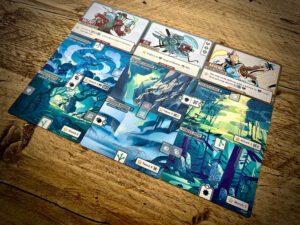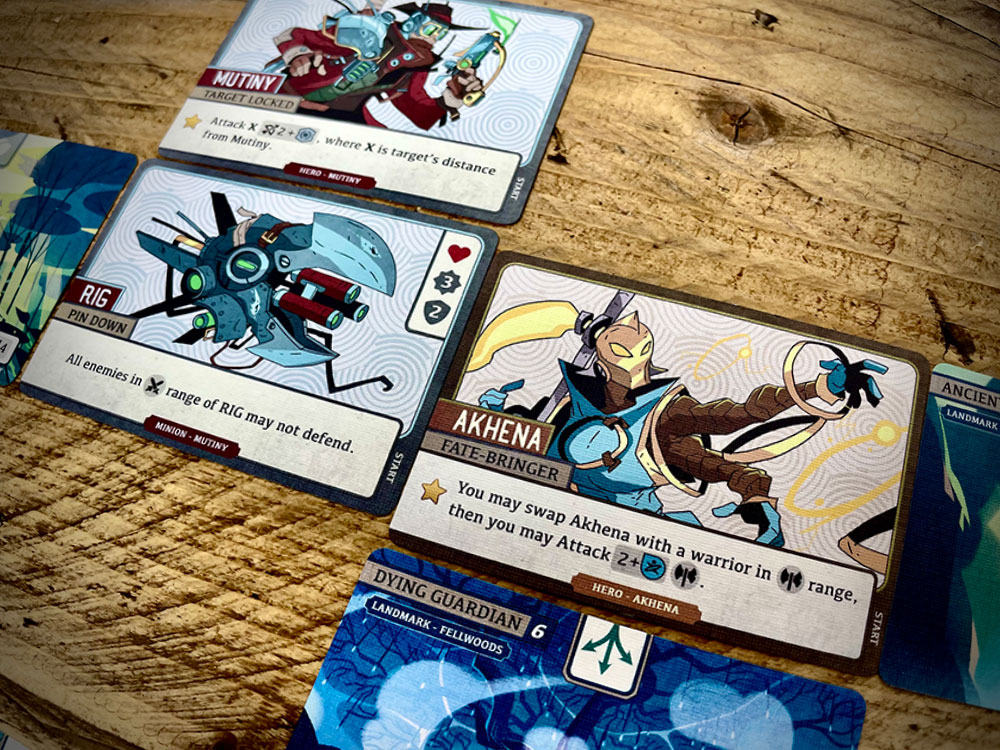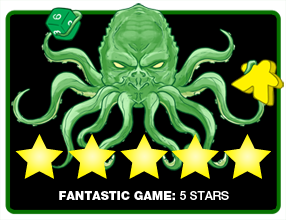 Legendarily powerful heroes face off across the Neververse to reveal the mark of the true champion in Battlecrest. This eighteen-card game successfully delivers the deep strategic elements you can expect from a tactical skirmish game. The amount of depth packaged into a game with only eighteen cards is remarkable. There are heroes, minions, multiple actions, items, special abilities, and even dynamic maps. Battlecrest boasts innovative gameplay, clever game mechanics, and a unique challenge that fits your pocket.
Legendarily powerful heroes face off across the Neververse to reveal the mark of the true champion in Battlecrest. This eighteen-card game successfully delivers the deep strategic elements you can expect from a tactical skirmish game. The amount of depth packaged into a game with only eighteen cards is remarkable. There are heroes, minions, multiple actions, items, special abilities, and even dynamic maps. Battlecrest boasts innovative gameplay, clever game mechanics, and a unique challenge that fits your pocket.
This is a Button Shy game, a publisher that is well known for producing pocket-sized eighteen-card games that come nicely packaged in a bi-fold wallet. Their games’ simplicity usually conceals their brilliant design, and Button Shy has developed a cult following line of games. Battlecrest has much to prove, and our conclusion is that it has what it takes to be the next hit from Button Shy.
Battlecrest is an asymmetrical skirmish game for two players (or one to four players with expansions). It is a fast-paced game that can be played in twenty minutes.
Gameplay Overview
Each character has six cards, including a hero card, a health tracker, action cards, and sometimes a minion or item. A 6×6 map is also constructed using six cards only; the cards are arranged randomly.

Players maneuver their characters around the dynamic map while unleashing powerful attacks to beat their opponents. When you play action cards, you “exhaust” them and reveal the characters’ “battlecrests,” which empower your hero and open up new possibilities. “Battlecrests” are unique symbols that make actions and abilities more powerful. At the same time, they are active when cards are “exhausted” or when a hero has low health points.
Each turn, a player takes two actions: it can move, activate and exhaust cards to use its abilities and reveal its “battlecrest,” exhaust a card without using its abilities to reveal its “battlecrest,” or refocus an exhausted card to bring it back into the game flipped and showing a new action.
Map terrains can aid the heroes and minions and also have shortcuts. However, some of them are hazardous and can damage the player. When a map terrain “ability” is used, the terrain card is flipped over, and the map dynamically changes.
One interesting mechanic is that the hero’s motion is based on the number of movements available by non-exhausted cards. If all your cards are exhausted, you cannot move. At the same time, the more exhausted cards you have, the more “battlecrests” are revealed and the stronger actions you can take.
No two battles will be the same since each character has unique actions and tactics.

Game Experience
The core of Battlecrest is a skirmish game, but an exciting mix of game mechanics emerges above the surface. A tiny package conceals a game of hand management, grid movement, a modular dynamic grid map, and asymmetrical gameplay. Heroes have unique abilities and actions; some have minions, some have items, and they are all unique.

The “battlecrest” mechanic that gives the game its name is simply astonishing. It is a straightforward mechanic that forces players to take tough decisions. Do you want to be mighty to the cost of actions, options, and maneuverability? Or would you rather be flexible but weaker and plan for winning in the long run? There is no single winning strategy in Battlecrest. You may even be compelled to change your plans halfway through a game to deceive your opponent and lead your quest to victory.
To win, players must outwit their opponents. There is no place for luck in Battlecrest, and you must be strategic, master your hero, and plan each action as you would in a game of chess. The only designed uncertainty in the game is the random placement of terrain cards. However, it does not create any imbalance in the gameplay and only adds to its replayability. This is not a game about randomness but about strategy.

The medium complexity when learning the game disappears once you are familiarised with the rules. After an initial steep learning curve, the game becomes straightforward while still being hard to master. It is a light game with deep strategy, as all the games I love are.
Being small, fast-paced, and quick makes it the ideal “filler” game. At the same time, it is a highly recommended gateway game to introduce new players to advanced skirmish game mechanics.
Final Thoughts
As we have learned from Button Shy games, Battlecrest amazes us with how much a game can deliver with eighteen cards only. It still surprises us and delivers the “wow” effect that only the most brilliant games have to offer. You will finish playing this game wanting more. Hopefully, a line of expansions will be released to keep us delighted.
Battlecrest is a must-have game if you are a fan of skirmish games and would love to have one always ready wherever you go. It is absolutely clever and does everything I would expect a brilliant game to do right. I’m astonished by how much this game accomplishes with eighteen cards only. It may not be for everyone’s tastes, and there is some complexity and a slightly steep learning curve to overcome. But I am not embarrassed to be biased when saying I fell in love with this game.
Final Score: 5 Stars – One of those few games that deliver to my highest expectations.
 Hits:
Hits:
• A great game in a tiny package.
• Clever, unique, genuine, and brilliant.
Misses:
• A sci-fi skirmish game may only be for some people’s tastes.
• There is some complexity and a slightly steep learning curve to overcome.





















